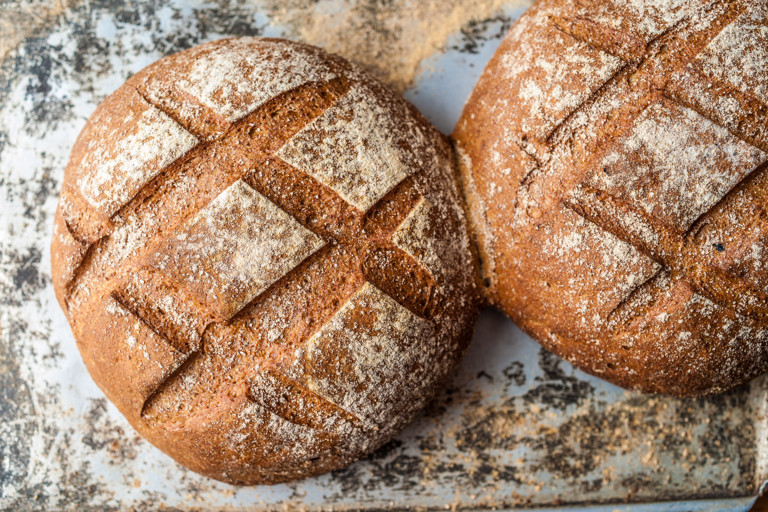Dark rye bread
Item 1 of 1
- Side
- medium
- 30
- 50 minutes
Distinguished for its gentle acidity and malty flavour, rye bread is a real all-rounder that can be enjoyed on its own or woven into a dish, such as salt beef and rye. In this dark rye bread recipe, Russell Brown uses a rye starter to extend the fermentation process and produce a more spirited flavour.
First published in 2015
discover more:
Ingredients
Metric
Imperial
Rye starter
- 140g of dark rye flour
- 100g of 00 flour
- 200g of water
- 50g of buttermilk
- 10g of fresh yeast
Dough
- 20g of fresh yeast
- 350g of water
- 10g of dextrose
- 50g of grapeseed oil
- 300g of rye flour, plus extra for dusting
- 400g of T55 flour
- 22g of sea salt, finely ground
SAVE RECIPE
Equipment
- Food mixer fitted with a dough hook
- Steam oven
- Proving baskets
Method
1
Begin by preparing the starter. Combine the dry ingredients in a large bowl. In a separate bowl, mix together the water and buttermilk
- 140g of dark rye flour
- 100g of 00 flour
- 10g of fresh yeast
- 200g of water
- 50g of buttermilk
2
Crumble the yeast into the buttermilk mix, then pour into the bowl of dry ingredients. Continue to stir until thoroughly combined
3
Cover the bowl tightly with cling film and refrigerate for 24 hours. Remove the starter from the fridge 1 hour before making the dough
4
To prepare the rye bread, combine the yeast, 75g of the water and the dextrose in the bowl of an electric mixer fitted with a dough hook attachment. Leave to stand for 10 minutes, then add the starter and the oil
- 20g of fresh yeast
- 75g of water
- 10g of dextrose
- 50g of grapeseed oil
5
Combine the flours and salt and sift into the mixer bowl. Turn the mixer on to the lowest speed, gradually add the remaining water and mix for 12 minutes
- 300g of rye flour, plus extra for dusting
- 400g of T55 flour
- 22g of sea salt, finely ground
- 275g of water
6
Scrape the bowl down to incorporate any unmixed flour and mix for a further 8 minutes on a low speed. Remove the bowl from the mixer, scrape down the sides and spray the surface of the dough with Trenwax or vegetable oil spray
7
Cover tightly with cling film and prove in a lukewarm place until doubled in size, for approximately 40 minutes depending on room temperature
8
Scrape the dough onto a work surface and gently divide into 4 pieces using a bread scraper. Shape into boules by folding in half, in half again in the opposite direction and finally in half once more, creating tension in the dough with each fold
9
Gently shape the dough into a smooth, round ball by dragging the dough towards you, keeping your hands in constant contact with the work surface. Once smooth, place into floured or lined proving baskets
10
Allow to prove until the dough has doubled in size, then gently invert onto floured baking trays. Slash the tops of the loaves with the tip of a sharp knife to create a crisscross pattern, spray with water and dust with rye flour
11
Preheat the oven to 230˚C/gas mark 9 (refer to step 13 if using a non-steam oven)
12
Cover and prove for a further 10-15 minutes, then bake in the oven for 15 minutes, with shots of steam at 5 minute intervals
13
In a non steam/combi oven, place 2 small metal dishes in the oven in step 11. Once you put the dough in the oven, pour a cup of water into one dish. Pour water into the other dish 5 minutes later
14
Whichever oven you are using, lower the temperature to 180°C/gas mark 4 and cook for a further 10 minutes - the loaves are cooked when they sound hollow if tapped on the base. Allow to cool for 30 minutes before slicing
Get in touch
Please sign in or register to send a comment to Great British Chefs.


